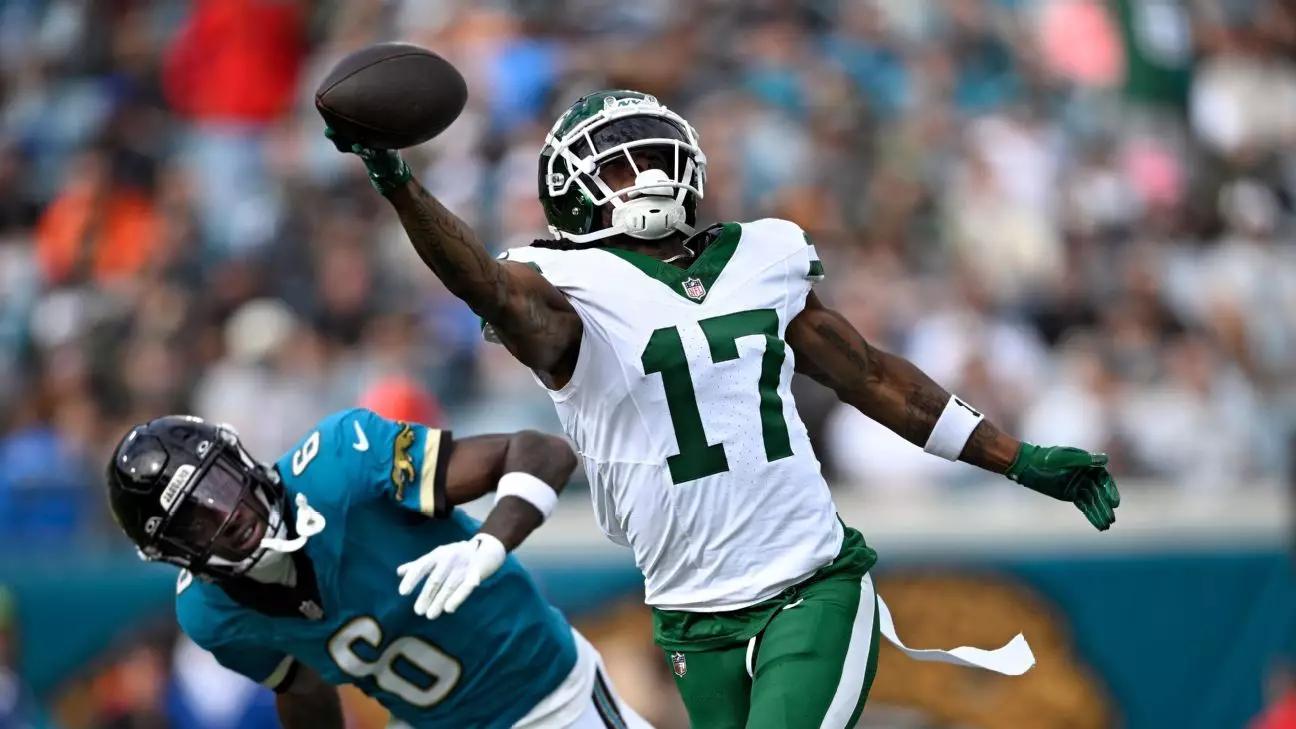The New York Jets find themselves at a critical juncture as they dismantle the remnants of an ambitious strategy that revolved around Aaron Rodgers. Just weeks after parting ways with the iconic quarterback, the Jets are making headlines again; this time, they’re releasing his preferred target, Davante Adams. This development doesn’t just signal a shift in roster composition; it is a pronouncement of the organization’s intent to clear the decks and embrace a new identity moving forward.
By releasing Adams, whose cap hit would have soared to a staggering $38.3 million, the Jets are not merely tightening their financial belt. They are illuminating the harsh reality of the post-Rodgers era. The decision to acquire Adams two seasons ago appeared to be a strategic masterstroke aimed at rekindling the magic that once electrified Green Bay. However, the consequences of that gamble are now painfully evident. With Adams’ exit, the Jets are pushing back against previous excesses and trying to regain financial flexibility, enabling them to be more aggressive in free agency.
Adams’ release offers the Jets substantial cap relief, clearing a massive $29.9 million this year. While it is a decisive step toward recovery, fans shouldn’t overlook the lingering dead cap charge of $8.4 million from his renegotiated bonus. Such numbers reveal a complex relationship with financial planning in a league where every dollar counts. Was the move to trade for Adams a mistake? Perhaps. But this release is a firm statement that the Jets are no longer tethered to decisions made in the glory chase, particularly when those moves failed to yield the desired fruit.
It’s clear that the Jets are aiming to rebuild both financially and strategically, but they’re also walking a tightrope. While other teams stockpile talent in preparation for the next season, the Jets are narrowing their roster options and reshaping their identity. The potentially pending trade of Allen Lazard reinforces this notion; as another Rodgers favorite, his departure likely will coincide with a wave of further restructuring. Thus, the Jets have taken critical steps to ensure they can attract new talent and foster an environment for a successful rebuild.
After Adams’ departure, Garrett Wilson emerges as the unequivocal alpha of the Jets’ receiving corps. While that may sound promising for his development, it poses significant challenges. Wilson had previously been caught in the shadows of the Adams-Rodgers connection, leading to an imbalance in target distribution. With his increased responsibility comes the pressure to perform, and it will be interesting to see how the young star responds.
In contrast, the Jets’ depth at the wide receiver position suffers considerably. Alongside Wilson, they are left with unproven talents like Xavier Gipson and Malachi Corley. This makes one ponder: are the Jets gambling on Wilson’s ascension while neglecting to build adequate support around him? Teams that put too much faith in one pivotal player often find themselves exposed and vulnerable, especially if injuries or other setbacks strike.
Moreover, the Jets’ philosophy now begs the question of how closely tied their trajectory will be to Wilson’s development. If he flourishes into the elite receiver they envision, the Jets could break free from this transitional period sooner than expected. If not, they may find themselves scrambling again next season to acquire fresh talent and restore balance to their offensive game.
As the offseason progresses, with personnel changes reflecting a significant organizational overhaul, the Jets must tread carefully. The departure of Adams and the potential trade of Lazard appear to be part of a larger vision. With new leadership at the helm—Coach Aaron Glenn and General Manager Darren Mougey—the Jets are not merely looking to just put players on the field; they are crafting a holistic approach to revamping their entire culture.
However, fans and analysts alike should remain vigilant. The decisions of the Jets’ front office must translate into meaningful progress on the field, especially given their tumultuous history laden with disappointment. The Jets may now be free from the weight of the previous regime’s choices, but the ultimate test lies ahead: will they combat the challenges of the upcoming season with newfound vigor, or will they continue to stumble in their quest for a sustained winning culture?
In the ever-competitive NFL landscape, the Jets’ calculated moves signal a new chapter. As they continue to navigate this off-season, the focus will not only be on who they add but on how well they develop the talent they possess. The road ahead is undoubtedly rocky, but with a clear strategy and courageous execution, the Jets may yet find their way out of the cloud of mediocrity.


Leave a Reply